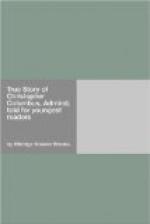But Columbus, after he had seen his good friend Juan Perez, the friar at Rabida, and told him all his adventures, went on to Barcelona where King Ferdinand and Queen Isabella were waiting for him. They had already sent him letters telling him how pleased they were that he had found Cathay, and ordering him to get ready for a second expedition at once. Columbus gave his directions for this, and then, in a grand procession that called everybody to the street or window or housetop, he set off for Barcelona. He reached the court on a fine April day and was at once received with much pleasure by the king and queen of Spain.
Columbus told them where he had been and what he had seen; he showed them the gold and the pearls and the birds and curiosities he had brought to Spain as specimens, of what was to be found in Cathay; he showed them the ten painted and “fixed-up” Indians he had stolen and brought back with him.
And the king and queen of Spain said he had done well. They had him sit beside them while he told his story, and treated this poor Italian wool-weaver as they would one of their great princes or mighty lords. They told him he could put the royal arms alongside his own on his shield or crest, and they bade him get together at once ships and sailors for a second expedition to Cathay—ships and sailors enough, they said, to get away up to the great cities of Cathay, where the marble temples and the golden palaces must be. It was their wish, they said, to gain the friendship of the great Emperor of Cathay, to trade with him and get a good share of his gold and jewels and spices. For, you see, no one as yet imagined that Columbus had discovered America. They did not even know that there was such a continent. They thought he had sailed to Asia and found the rich countries that Marco Polo had told such big stories about.
Columbus, you may be sure, was “all the rage” now. Wherever he went the people followed him, cheering and shouting, and begging him to take them with him on his next voyage to Cathay.
He was as anxious as any one to get back to those beautiful islands and hunt for gold and jewels. He set to work at once, and on the twenty-fifth of September, 1493, with a fleet of seventeen ships and a company of fifteen hundred men, Columbus the Admiral set sail from Cadiz on his second voyage to Cathay and Cipango and the Indies. And this time he was certain he should find all these wonderful places, and bring back from the splendid cities unbounded wealth for the king and queen of Spain.




